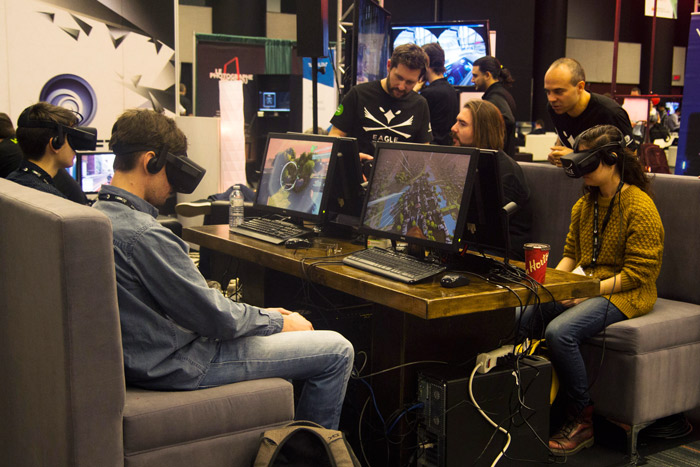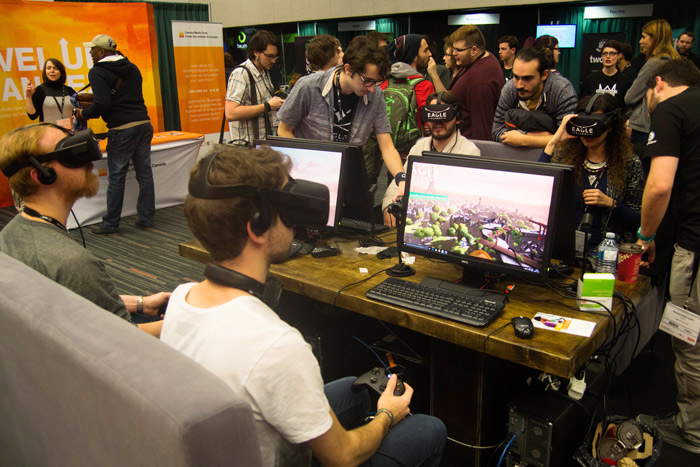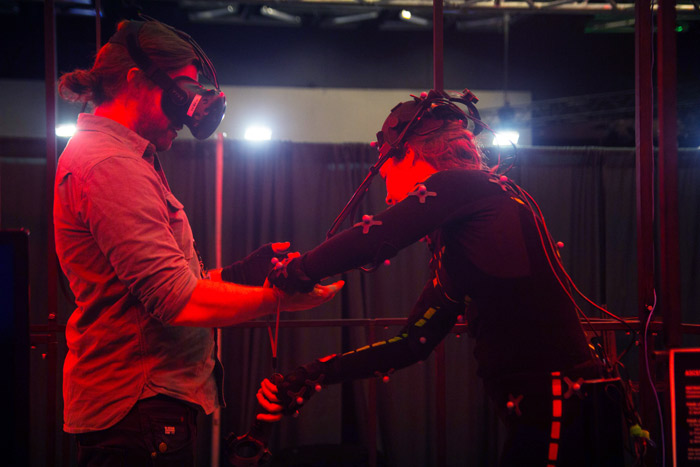Every year, thousands of gaming conventions are held around the world to discuss what the future holds. Demonstrators, presenters, and indie developers show up to sell their wares and talk about the “next big thing.” At this year’s Montreal International Game Summit (MIGS), held Nov. 13 to 15 at the Palais des Congrès, augmented reality (AR) and virtual reality (VR) were the obvious stars of the show.
The summit featured both indie game developers and major production companies—including Ubisoft, EA, PlayStation, and Microsoft—who demonstrated new games and technologies. MIGS also hosted lectures on all things videogames and featured a job fair for networking and interviewing with recruiters.
“It’s always important for us to be [at MIGS] because we want to meet the community,” Fabrice Giguère, public relations manager at Ubisoft Montreal, said. “We want to meet the people, but we also want to represent the industry [of video games] that saw its growth over the past 20 years. We have our recruiters, students can come and give us their resumes, we can talk about job openings, and so forth.”
Providing a platform to connect industry professionals is a key component of MIGS’ success.
“We’ve had really good conversations,” Katie Jo Turk, a hardware expert and performance capture supervisor at Faceware Technologies—a motion capture studio—said. “We’ve had great potential leads come to our booth, […] people who are making games, [and] indie developers who are just starting out.”
VR has recently captured the imaginations of many in the gaming industry. Nearly all of the largest stations on the conference floor had a VR setup. Convention-goers had a chance to put on a VR or AR headset—including the Oculus Rift, HTC Vive, Playstation VR headset, or Microsoft Hololens—to explore what many believe to be the future of video games.
“It definitely seems like VR is a focus.” Technical Marketing Manager and tech evangelist at Autodesk, Matthew Doyle, said. “There have been several VR related talks. There are multiple booths that have VR setups.”

Doyle, who has attended six MIGS conferences, noted that this summit was different from years past.
“Last year, VR was barely a twinkle in anybody’s eye,” Doyle said. “It was being talked about, but you didn’t see a lot of it here at MIGS.”
This contrast is due in large part to advancements in the technology over the last year. Major studios–or “the big guys,” as Doyle called them–are starting to invest more money into VR to form a viable industry. Simultaneously, more VR devices are finding their way into the hands of consumers and developers as the technology is further researched, but there is still a long road ahead.
“Everyone is waiting for the studios to follow [by making games for VR devices], because obviously if you have the hardware without the content, it’s only a piece of plastic,” Giguère said.
Because VR is almost an entirely new medium, developers are only just exploring new ways to use virtual reality in their games. Despite headsets becoming more technologically advanced, the software that can be used on them is relatively limited compared to the sheer number of games available on traditional platforms, such as consoles and personal computers.
The unfamiliar nature of VR and AR is also off-putting to many consumers.
“Some people, after 20 minutes, they say they are tired of it,” Turbulent CEO Marc Beaudet said. ”Sometimes in gaming, you’re going to sit for four, five hours, so how can you adapt a game in which you play hours and hours for a technology which, right now, is a bit uncomfortable after [20] minutes?”
Beaudet, whose company works in the video game, education, and entertainment industries, also noted the monetary difficulties of building a business based on VR. Currently, he explained, VR is difficult to make into a workable business model as it often results in a loss.
Microsoft has also stepped into with ring of augmented reality with the Hololens, a different type of headset.
Instead of replacing the real world with a simulated reality like in a video game, the Hololens lets the user interact with the real world in a way much like Tony Stark in the Iron Man movies: By tapping and moving holograms projected over reality by the headset—referred to by Microsoft as mixed reality.
“It’s a fully untethered mixed reality device that projects holograms into the world around you,” Sage Franch, a tech evangelist at Microsoft, said. “These holograms can interact with the space around you, and it’s constantly mapping your room and your environment so that it provides the best experience possible.”
It might seem like science fiction, but it really works. Holograms and animations interact almost flawlessly with the real world; with endless implications for designers, engineers, doctors, and the average consumer—once the product is mass released, that is. For now, a developer version of the headset is available for $3,000 from Microsoft.

Other industry players that have been steadily growing also showed off their latest and greatest at MIGS. Gameloft, a mobile games studio, presented several games, including Dungeon Hunter 5 and the upcoming game Modern Combat Versus. Thanks to the ubiquity of smartphones, mobile games are more and more accessible to people around the world.
“A lot of people used to think that video games were only for men or teenagers,” Loïc Ramboanasolo, a producer of Modern Combat Versus, said. “And now on mobile, it’s actually women that are more predominant [gamers] than men.”
This expanding landscape makes it easier to reach new audiences around the world, allowing for a more universal gaming experience.
Though the gaming industry is drastically changing due to its expansion to new mediums, traditional video games remained a staple of the convention. An array of indie developers occupied a good part of the convention floor. Each developer had a small cubicle, called an “Indie Pod,” where they set up their own demonstrations of traditionally-styled games.
Ubisoft, in addition to demonstrating a new VR game called EagleFlight, promoted the release of Watch Dogs 2, an open-world game released publicly on the third day of the conference. Meanwhile, Warner Brothers Games showcased Batman: Arkham Knight.
At its heart, the convention remained focused on a group of people with a shared interest in video games.
“[It’s] kind of a geeky thing,” said Doyle. “There’s just something magical about creating some art from start to finish, seeing it come to life. And as for VR, well, I never get tired of seeing someone who’s never tried it before put it on [….] They’re like, ‘Whoa, that’s amazing!’”
And it is. A tangible feeling of awe was in the air at MIGS. A line wrapped around the Microsoft booth to try on the Hololens and rarely was a headset sitting on a chair unused. Whether VR will becomes massively popular remains to be seen, but for now, simply testing out a new way to experience reality is nothing short of incredible.








